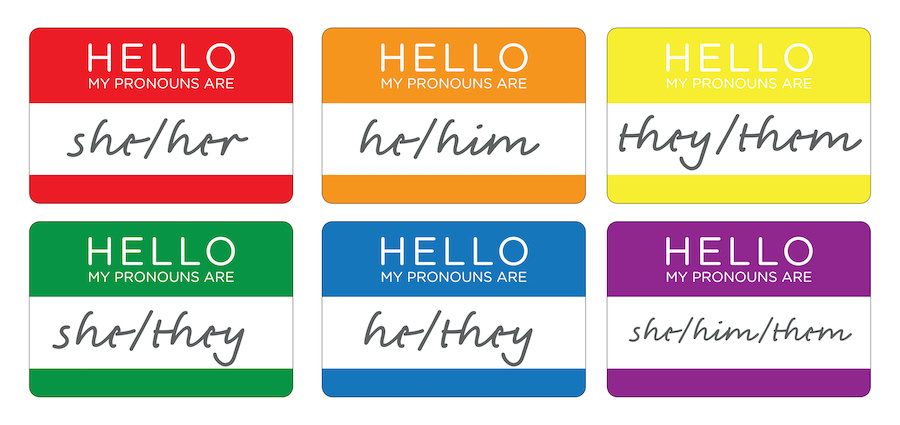Honor One Another: Pronouns in Practice
By Eli Bonilla
October 2021
As PR professionals, we have the opportunity — and the responsibility — to honor the extraordinary diversity around us. One way we can do this is to join the conversation about personal pronouns.
Increasingly, people are adding their pronouns to introductions, email signatures and presentation headings. Doing so helps share a part of oneself and normalizes conversations about gender and identity. This approach comes naturally for some but is uncharted territory for others.
Gender is a spectrum, so it’s essential that we use accurate words to describe others and their identity.
Gender identity
Someone I love and admire shared this story:
“One of my greatest moments of joy as a child happened at a restaurant with my extended family. I was sitting next to my cousin and wearing a new hat. We were the only two kids at the table of 20 and after we placed our drink orders, the waitress read back, ‘…and Sprites for the two boys.’ It was the first time someone recognized I wasn’t a girl, so I wore that hat for years as if it was a magic portal for others to glimpse beyond my biology. Years later, I realized that gender isn’t binary and I’m not either.”
Typically assigned at birth, sex refers to the biological and physiological characteristics of females, males and intersex people. Differences range from chromosomes and hormones to reproductive organs. Even sex exists on a spectrum.
Gender identity refers to one’s personal sense of self and gender. It involves a range of characteristics including femininity, masculinity and neutrality. An individual may identify as a woman, man, both or neither. Multiple words and phrases are available to describe identity and how it correlates with, or differs from, one’s assigned sex. It’s up to the person to decide what term to use and when to share it.
Gender expression is one’s presentation of identity through clothing, voice, name and other characteristics. An individual may express more or less of their gender identity at any given time or situation, whether out of personal choice or for self-protection.
Sexual orientation is different, though related. It involves physical, spiritual and emotional attraction based on another person’s sex and gender in relation to one’s own.
Understanding these differences is important because the English language uses pronouns, honorifics and other words that may imply gender.
Ask, don’t assume
When it comes to gender, the best and easiest way to learn a person’s pronouns is to introduce yours and ask theirs: “Hi — my name is (your name) and my pronouns are (your pronouns). What about you?”
This simple framing is an everyday way to share a part of yourself and to open the door for others to share a part of themselves. It gives you clarity and accuracy for communications and demonstrates professionalism and openness.
Whether you’ve known someone for years or met them today, your perception of their gender isn’t necessarily their truth. Someone’s description of their gender can also change over time, so it’s always good to ask.
If you don’t have an opportunity to ask about pronouns, use the person’s name and write or speak around the pronouns. If pronouns are essential, use they/them.
Use inclusive language
Most important, once you have learned someone’s pronouns, use them. When introduced to pronouns that aren’t familiar, take time to learn how to use them because that’s how you will refer to them — or hir, ver, (f)aer, em, xem, or per.
Using correct pronouns shows respect and builds an inclusive environment. As a co-worker commented, “Life is hard enough. Why would I want to make it harder for someone when a simple change of word or phrasing could contribute to their happiness?”
If you know someone’s pronouns and inadvertently use the wrong one, apologize and move on: “(wrong pronoun), sorry (correct pronoun).” It’s that easy — well, almost.
Here’s the hard part: If you misgender someone, it’s your responsibility to figure out why and make the change. It’s not the responsibility of someone else to do the work, change themselves or answer obtrusive questions.
Many reputable resources on gender theory and pronouns can be found with a few clicks of a computer mouse.
If someone you know is nonbinary and uses they/them pronouns, ask yourself if you recognize that person as nonbinary. Do you struggle to use he/him for someone you grew up calling she/her because you haven’t shifted your understanding or behavior? It may not be comfortable for you at first, but making the change is worth it — for relationships and for business.
Consider additional ways that you can communicate more clearly through inclusive language. When creating a survey, for example, you might add additional options — such as a fillable “other” — for questions related to sex and gender (and ask yourself whether those questions are even necessary on the survey).
When writing a letter, you might address the recipient directly by name or use a gender-neutral option such as “Mx.,” followed by the person’s name. Rather than use “he/she,” use “they” to connect with more people. Opportunities abound.
According to the Linguistic Society of America, “inclusive language acknowledges diversity, conveys respect to all people, is sensitive to differences and promotes equal opportunities.”
Any time we can use language to support and respect others, connect people and expand understanding, we can make a difference. Isn’t that what public relations is all about?



